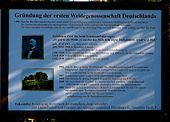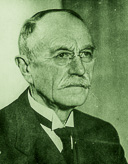Friedrich Falke
Friedrich Falke (born July 7, 1871 in Schwarzholz , Altmark ; † March 10, 1948 in Arendsee , Altmark) was a German agricultural scientist . His areas of interest included arable and plant cultivation , agricultural management , and above all grassland theory . The results of his research were trend-setting for modern, rational pasture management and for fodder cultivation .
Life

Friedrich Falke, son of a landowner, studied agriculture at the University of Halle (Saale) since 1890 . Under the aegis of Julius Kühn , the most important agricultural scientist in Germany at the time, he received his doctorate in 1895 with a dissertation on the feed value of brown hay . During its production, the water contained in the plants is not only withdrawn by simply drying them (as with hay ); rather, a fermentation process is set in motion, which leads to self-heating and thus to complete drying of the hay.
In 1898 he completed his habilitation in Halle with a thesis on the milk secretion of cattle. In the following three years he taught as a private lecturer at the Agricultural University Institute in Halle. In 1901 he accepted an appointment as an associate professor for crop production and animal breeding at the University of Leipzig . His research focus was the pasture economy.
The First World War ended this first period of his activity at the University of Leipzig. In 1914 he had to go to the front as a captain. He served as a company commander of the 3rd Company in Brigade Replacement Battalion No. 15 of the IV Replacement Division and was awarded the Iron Cross 1st and 2nd Class.
In 1918 he resigned from university. His successor at the University of Leipzig was Adolf Zade . As Ministerialrat in the Saxon Ministry of Economics, he took on the task of increasing agricultural production in Saxony. In this position he promoted the expansion of agricultural research institutes. In Pommritz he established an institute for agricultural labor research and in Pillnitz he prepared the establishment of a higher education and research institute for horticulture. He also reorganized the agricultural school system and the advisory services for farmers.
In 1920, Falke accepted a second call at the University of Leipzig, now as a full professor for agricultural management . In 1933 he went to Ankara on behalf of the Turkish government to the newly founded University of Agriculture, Forestry and Veterinary Science. He worked here as the rector of this university for five successful years and, at the request of the Turkish government, filled most of the chairs with German professors. In 1938 he returned to Germany and lived as an emeritus in Arendsee. On March 6, 1948, he received an inquiry from the Philosophical Faculty of the University of Leipzig to play a key role in the reconstruction of the agricultural institutes. He was unable to accept this third appointment to Leipzig: he died four days later.
plant

Falke's scientific work was strongly influenced by the “Halle School” of his teacher Julius Kühn , who still regarded agricultural science as an encyclopedic unit. As a university lecturer, Falke was therefore involved in numerous agricultural sub-areas, but his real research area was pasture management throughout his life. As a student and later as a private lecturer, he had already recognized the importance of pasture management for successful farm management on his parents' farm and had proven through his own experiments that pasture yields can be sustainably increased through fertilization and proper pasture management.
When he accepted the call to the University of Leipzig in 1901, he immediately started new pasture experiments in the Vogtland ; they were the first ever in the state of Saxony. The positive experiences on these test areas led to the establishment of the first Saxon cooperative pasture in Ehrenberg ( Sebnitz district ) in 1906 . Falke had shown agricultural practice the way to intensive grassland use and opened up new possibilities for cattle breeding.
The system of the modern rotary pasture was developed by Falke in all essential points as early as 1905 until it was ready for practical use. In 1907 he published his book " Permanently Pastures ", of which revised editions appeared in 1911 and 1920. For more than thirty years, the book was the authoritative reference work for students of agriculture and pastoralists and had a lasting influence on pasture management and grassland research. A fourth edition of the work, on which Falke worked as emeritus, has not been published.
In addition to his teaching activities at the University of Leipzig, Falke went on numerous lecture tours in northern and central Germany and tried to explain the economic advantages of the new pasture management to farmers. In 1907 he conducted the first course in pasture management in Germany. However, the events of the First World War initially brought a standstill, in some cases even a decline in the development of intensive pasture operations.
In the second period at the University of Leipzig between 1920 and 1933, Falkes' main interest was primarily in pasture and fodder management, now more from an economic point of view. During these thirteen years, Falke developed the greatest broad impact. His practice-oriented courses inspired many students and carried his reputation beyond Germany's borders. From then on, Leipzig and Saxony were regarded as centers of grassland research in Germany.
Working in numerous agricultural organizations, some of which he founded himself, he maintained close contacts with agricultural practitioners. From 1919 to 1932 Falke was chairman of the arable farming department of the German Agricultural Society . In 1921 he founded a “special committee for meadows and pastures” within this organization, which he chaired until 1933. In 1923 he founded a “Working Group for Grassland Management”, in 1925 an “Information Center for Grassland Management” in Annaberg / Erzgebirge and in 1927 a “Landing Point for Research into Agricultural Business Conditions in Saxony”.
Due to the variety of research problems in grassland management, Falke recognized at an early stage the need to foster an international exchange of ideas in this field. In his function as chairman of the arable farming department of the German Agricultural Society, he invited around 50 grassland experts from Germany, Austria, Sweden, Finland, Denmark, the Netherlands and Switzerland to the “1. Gathering of pasture and meadow landlords from northern and central European countries ”to Leipzig. From May 20 to 31, 1927, the important conference that was subsequently declared the 1st International Grassland Congress took place . Thanks to Falke's services, Leipzig was designated the permanent seat of the “Central Office of the Association of International Grassland Congresses”. These international specialist congresses take place every four years to this day.
In addition to numerous articles in specialist journals and his main work " Die Permanweiden ", Falke has published other books on grassland management. " Meadows and pastures " (1908), " The pasture economy " (1919) and " The most important grasses on meadows and pastures " (1929) deserve special mention . From 1913 to 1938, in collaboration with changing employees, Falke published the " Yearbook on Newer Experiences in the Field of Pasture Management and Forage Production ". His “ Commemorative Speech for the 100th Anniversary of Albrecht Daniel Thaer's Death ” (1929) is noteworthy in terms of the history of science .
Main publications
- Making brown hay . Work of the German Agricultural Society Volume 9, 1895. - Revised ibid. Volume 111, 1905.
- The milk secretion of cattle under the influence of high-fat feeding . Habil.-Schr. Univ. Hall 1898.
- Agricultural teaching revision course. A guide for students and farmers . Publishing house F. Starke Halle 1901.
- Investigations into the influence of fertilization on meadows and pastures . Publishing house RC Schmidt & Co. Leipzig 1904.
- Tasks and goals of the German agricultural enterprise . Publishing house Th. Thomas Leipzig 1904.
- The permanent pastures. Significance, installation and operation of the same with special consideration of intensive economic conditions . Verlag M. & H. Schaper Hannover 1907; 2nd edition ibid. 1911; 3rd edition, ibid. 1920.
- Meadows and pastures . Verlagbuchhandlung Max Jänecke Hanover 1908 = Library of the whole of agriculture, vol. 19; New edition ibid. Leipzig 1921 = Handbook for the whole of agriculture Dept. 49–52.
- Pasture farming . Verlag Eduard Meyer Friedrichswerth 1919 = Agricultural Library Vol. 16.
- The most important grasses in meadows and pastures . Publishing bookstore Paul Paery Berlin 1929 = Parey's pocket atlases No. 8.
- Commemorative speech for the 100th anniversary of Albrecht Daniel Thaers' death . Leipzig 1929 = work of the Leipzig Economic Society .
literature
- Prof. Dr. Falcon † . In: Die Deutsche Landwirtschaftliche Presse vol. 72, 1949, No. 38, p. 10.
- M. Jokusch: In memory of privy councilor Prof. Dr. Friedrich Falke . In: Das Grünland Vol. 1, 1952, p. 30 (with picture).
- Otto Heuser: Friedrich Falke, farmer . In: Neue Deutsche Biographie Vol. 5, 1961, p. 9.
- Wilhelm Lampeter : Friedrich Falke (1871-1948) . In: Important scholars in Leipzig Vol. 2. For the 800th anniversary of the city of Leipzig on behalf of the Rector and Senate of the Karl Marx University, edited by Gerhard Harig. Leipzig 1965, pp. 159–164 (with picture).
- Th. Kramer and C. Teucher: Prof. Dr. Friedrich Falke in memory . In: Zeitschrift für Landeskultur Vol. 9, 1968, pp. 181-183 (with picture).
Web links
- Literature by and about Friedrich Falke in the catalog of the German National Library
- Overview of Friedrich Falke's courses at the University of Leipzig (summer semester 1902 to summer semester 1914)
- Friedrich Falke in the professorial catalog of the University of Leipzig
- Entry on Friedrich Falke in the Catalogus Professorum Halensis
Individual evidence
- ↑ According to the NDB, he died in Gollensdorf , Altmark . See Volume 5, 1961, p. 9 .
- ↑ From the book table. In: Wiener Landwirthschaftliche Zeitung. Illustrated magazine for the whole of agriculture / Wiener Landwirthschaftliche Zeitung. General illustrated magazine for the whole of agriculture / Wiener Landwirthschaftliche Zeitung. Illustrated newspaper for the whole of agriculture / Wiener Landwirtschaftliche Zeitung. General illustrated magazine for the whole of agriculture / Wiener Landwirtschaftliche Zeitung. Illustrated newspaper for the whole of agriculture , June 6, 1896, p. 4 (online at ANNO ).
- ↑ Friedrich Falke: About pasture management and forage production. In: Wiener Landwirthschaftliche Zeitung. Illustrated magazine for the whole of agriculture / Wiener Landwirthschaftliche Zeitung. General illustrated magazine for the whole of agriculture / Wiener Landwirthschaftliche Zeitung. Illustrated newspaper for the whole of agriculture / Wiener Landwirtschaftliche Zeitung. General illustrated magazine for the whole of agriculture / Wiener Landwirtschaftliche Zeitung. Illustrated newspaper for the whole of agriculture , March 27, 1915, p. 5 (online at ANNO ).
- ↑ Staff news . In: Wiener Landwirthschaftliche Zeitung. Illustrated magazine for the whole of agriculture / Wiener Landwirthschaftliche Zeitung. General illustrated magazine for the whole of agriculture / Wiener Landwirthschaftliche Zeitung. Illustrated newspaper for the whole of agriculture / Wiener Landwirtschaftliche Zeitung. General illustrated magazine for the whole of agriculture / Wiener Landwirtschaftliche Zeitung. Illustrated newspaper for the whole of agriculture , February 8, 1919, p. 4 (online at ANNO ).
| personal data | |
|---|---|
| SURNAME | Falke, Friedrich |
| SHORT DESCRIPTION | German agronomist |
| DATE OF BIRTH | July 7, 1871 |
| PLACE OF BIRTH | Schwarzholz , Altmark |
| DATE OF DEATH | March 10, 1948 |
| PLACE OF DEATH | Arendsee , Altmark |

